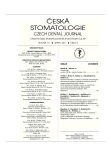Evalutation of Antimicrobial Effect of Ozonated Water for Disinfection Dental Impressions
Authors:
V. Seidler 1; H. Hubálková 1; A. Jedličková 2; I. Linetskiy 1; H. Staňková 1; J. Mazánek 1; R. Šmucler 1
Authors‘ workplace:
Stomatologická klinika 1. LF UK a VFN, Praha
1; ÚKLBD, Klinická mikrobiologie a ATB centrum, VFN, Praha
2
Published in:
Česká stomatologie / Praktické zubní lékařství, ročník 111, 2011, 4, s. 89-95
Category:
Original Article – Clinical Study
Overview
Introduction:
Presence of microbes on the surface of dental impressions poses a risk of spread of infection on dental office staff and also on dental technicians. The standard disinfection of dental impressions is carried out by immersion in disinfective solution or spraying by disinfectant. The commonly used solutions are based on aldehydes, quarter ammonium, isopropyl alcohol, kalium-peroxomonosulphate, tartar acid and chlorine. Regular interchange of disinfective agents is required because of microorganisms’ resistance. We consider ozone, which possesses antimicrobial, antiviral and antimycotic properties, as a promising disinfective agent.
Aim:
The aim of our study was to evaluate efficacy of ozonated water as a possible disinfective agent for dental impressions.
Materials and methods:
A total amount of 180 impressions were taken from 90 volunteers. First group of 90 impressions served as control group and second group was treated by antimicrobial ozonated water with concentration of 8, 10, 12, 13.5 mg/l and exposition time of 10, 15 and 20 minutes. Samples were cultivated on hard and fluid growth media. Bacteriologic examination of aerobic, microaerobic and anaerobic bacteria was carried out.
Results:
Solution of 13.5 mg of ozone in 1 liter of water eliminated all microorganisms in all groups of samples.
Conclusion:
13.5 mg/l concentration of ozone in water is thought to be a promising agent for disinfection of dental impressions.
Key words:
ozonated water – disinfection of dental impressions – antimicrobial effect
Sources
1. ADA Council on Scientific Affairs and ADA Council on Dental Practice: Infection control recommandations for the dental office and the dental laboratory. J. Am. Dent. Assoc., roč. 127, 1996, s. 672–680.
2. Al-Jabrah, O., Al-Shumailan, Y., Al-Rashdan, M.: Antimicrobial effect of 4 disinfectants on alginate, polyether, and polyvinyl siloxane impression materials. Int. J. Prosthodont., roč. 20, 2007, s. 299–309.
3. Arabi, G. L., Zanarotti, E., Fonseca, R. G., Santos Crus, C. A.: Effect of disinfectans agents on dimensional stability of elastomeric impression materials. J. Prosthet. Dent., roč. 81, 1999, s. 621–624.
4. Arita, M., Nagayoshi, M., Fukuizumi, T., Okinawa, T., Masumi, S., Morikawa, M., Kakinoki, Y., Nishihara, T.: Microbicidal efficacy of ozonated water against Candida albicans adhering to acrylic denture plates. Oral Microbiol. Immunol., roč. 20, 2005, s. 206–210.
5. BDA Adice Sheet A12: Infection control in dentistry [on line]. BDA February 2003. Dostupný na URL adrese: <http://universitydental.co.uk/resources/bda-cross-infection.pdf>.
6. Bezirtzoglou, E., Cretoiu, S. M., Moldoveanu, M., Alexopoulos, A., Lazar, V., Nakou, M.: A quantitative approach to the effectivenees of ozone against microbiota organisms colonizing toothbrushes. J. Dent., roč. 36, 2008, s. 600–605.
7. Giammanco, G. M., Melilli, D., Rallo, A., Pecorellla, S., Mammina, C., Pizzo, G.: Resistence to disinfection of polymicrobial association contaminating the surface of elastomeric dental impressions. New Microbiol., roč. 32, 2009, s. 167–172.
8. Kaplan, B. A., Goldstein, G. R., Boylan, R.: Effectiveness of a professional formula disinfectant for irreverssible hydrocolloid. J. Prosthet. Dent., roč. 71, 1994, s. 603–606.
9. Kotsiomiti, E., Tzialla, A., Hatjivasiliou, K.: Accuracy and stability of impression materials subjected to chemical disinfection – a literature review. J. Oral Rehabil., roč. 35, 2008, s. 291–299.
10. van Noort, R.: Introduction to dental materials. 3rd ed., Elsevier, 2007, s. 204–207.
11. McCabe, J. F., Walls, A. W. G.: Applied dental materials. 9th ed., Wiley-Blackwell, March 28, 2008, s. 145.
12. Pereira, T., Cury, A. A. D. B., Cenci, M. S., Rodrigues-Garcia, R. C. M.: In vitro candida colonazation on acrylic resins and denture liners influence of surface free energy, roughness, saliva, and adhering bacteria. Int. Prosthodont., roč. 20, 2007, s. 308–310.
13. Russel, A. D.: Bacterial adaptation and resistance to antiseptics, disinfectants and preservatives is not a new phenomenon. J. Hosp. Infect., roč. 57, 2004, s. 97–104.
14. Sofou, A., Larsen, T., Öwall, B., Fiehn, N. E.: In vitro study of transmission of bacteria from contaminated metal models to stone models via impressions. Clin. Oral Invest., roč. 6, 2002, s. 166–170.
15. Stopka, P.: Ozon. 1. Fyzikální, chemické, biologické vlastnosti a účinky, výskyt v přírodě, detekce, manipulace. Progresdent., 2003, č. 6, s. 8–11.
16. Tan, H., Hooper, P. M., Buttar, I. A., Wolfaardt, J. F.: Effect of disinfecting irreversible hydrocolloid impressions on the resultant gypsum cysta: Part II – Dimensional changes. J. Prosthet. Dent., roč. 70, 1993, s. 532–537.
17. Thanomsub, B., Anupunpisit, V., Chanphetch, S., Watcharachaipong, T., Poonkhum, R., Srisukonth, C.: Effects of ozone treatment on cell growth and ultrastructural changes in bacteria. J. Gen. Appl. Microbiol., roč. 48, 2002, s. 193–199.
18. Wood, P. R.: Cross infection control in dentistry: a practical illustrated guide. Wolfe, 1992, s. 54–55.
Labels
Maxillofacial surgery Orthodontics Dental medicineArticle was published in
Czech Dental Journal

2011 Issue 4
Most read in this issue
- Cysts of Mandible and Maxilla. Etiology, Diagnostic Tools and Treatment Possibilities
- Burning Mouth Syndrome – The Most Common Causes of Our Patients
- Dental Erosions
- Evalutation of Antimicrobial Effect of Ozonated Water for Disinfection Dental Impressions
